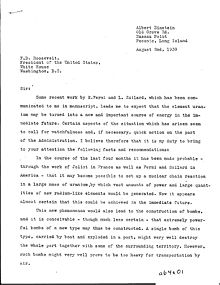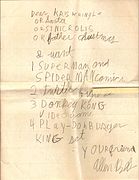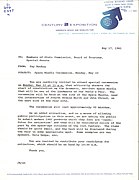Letter (message)
This article needs additional citations for verification. (June 2007) |


A letter is a written message from one party to another containing information. Letters guarantee the preservation of communication between both parties. They bring friends or relatives closer together, enrich professional relationships and provide a satisfying mean of self-expression. Letters contribute to the protection and conservation of literacy, which is the ability to write and read. [1] Letters have been sent since antiquity and are mentioned in the Iliad [2] by Homer (lived around 7th or 8th centuries B.C.). Works by both Herodotus and Thucydides, also mention letters.[3]
History of letter writing
This section needs expansion. You can help by adding to it. (December 2013) |
Historically, letters have existed from the time of ancient India, ancient Egypt and Sumer, through Rome, Greece and China, up to the present day. During the seventeenth and eighteenth century, letters were used to self-educate. Letters were a way to practice critical reading, self-expressive writing, polemical writing and also exchange ideas with like-minded others. For some people, letters were seen as a written performance. For others, it was not only seen as a performance but also as a way of communication and a method of gaining feedback. Nowadays, letters make up several of the books of the Bible. Archives of correspondence, whether for personal, diplomatic, or business reasons, serve as primary sources for historians. At certain times, the writing of letters has risen to be an art form and a genre of literature, for instance in Byzantine epistolography.[4]
In the ancient world letters were written on a various different materials, including metal, lead, wax-coated wooden tablets, pottery fragments, animal skin, and papyrus. From Ovid, we learn that Acontius used an apple for his letter to Cydippe.[5]
As communication technology has diversified, posted letters have become less important as a routine form of communication. For example, the development of the telegraph drastically shortened the time taken to send a communication, by sending it between distant points as an electrical signal. At the telegraph office closest to the destination, the signal was converted back into writing on paper and delivered to the recipient. The next step was the telex which avoided the need for local delivery. Then followed the fax (facsimile) machine: a letter could be transferred electrically from the sender to the receiver through the telephone network as an image. Today, the internet, by means of email, plays a large part in written communications; however, these email communications are not generally referred to as letters but rather as e-mail (or email) messages, messages or simply emails or e-mails, with the term "letter" usually being reserved for communications on paper.
The study of letter writing
Due to the timelessness and universality of letter writing, there is a wealth of letters and instructional materials (for example, manuals, as in the medieval ars dictaminis) on letter writing throughout history. The study of letter writing usually involves both the study of rhetoric and grammar.[6] Although the appearance of the letter and the way it is narrated matters, the message has precedence over the form. Letters should reflect the sender´s personality and thoughts, this is called creative letter writing. A letter is a product in its own right. As it is stated in the section about the history of the letter, letters are becoming less popular due to new and faster ways of communication. To preserve letter writing, a rich old art, motivation to share feelings and thoughts with others in an early childhood becomes essential. It is important to promote the study of letter writing showing that writing letters can be interesting and that it brings advantages. Suggestions to write letters:
When writing letters to friends or relatives:
- Letters should sound like a real conversation
- The tone of the letter can be made more conversational by adding one interesting personal anecdote
- Address the person by name occasionally
- Contractions add a more friendly and informal touch to letters
- A letter should never be too discreet[clarification needed]
- Punctuation as in a real conversation[clarification needed]
When writing formal letters:
- Emphasis important words and ideas
- Formal language
- The address and the date should go at the top of the first page
- Make clear when one sentence ends and another begins
- "A letter must not preach or argue"[who?]
Letters used in the classroom
Letter writing is commonly used in elementary and middle schools as a method of highlighting individuality, helping children gain proficient writing skills, and enabling them to practice better written communication. The skill of writing letters plays an important role in a middle school student's transitional experience from childhood to maturity. Living with adults who look out for their interests takes away their independence. However, as a writer their voice is valued and they're recognized as individuals.
Writing letters to pen pals is also a very common activity used by elementary and middle school teachers. Communicating with pen pals from different countries helps promote favorable interracial attitudes. Occasionally writing in a different language would also help the student learn more about that certain language. From writing letters to to exchanging gifts, students are being exposed to more of the culture.
Writing to other students, family members, and elected officials also promotes meaningful written communication. Letter writing is good for beginner writers, because the language used is closest to normal speech. The language used in letters captures the spontaneity in everyday speech that's unable to be expressed in other forms of text. Letters are personal, which makes them more meaningful. Children are also taught to write a variety of letter types such as thank you letters, letters of congratulation, fan letters, invitations, fan letters, and friendly letters. By writing letters, children are capable of developing better communication skills as well as improving their literacy skills. Children who are poor at writing letters typically lack experience in writing in general. By writing letters, their imagination can be expressed and they become more proficient in writing.
Letters used in science
Back when modern technology wasn't available for convenient communication, the exchange of letters was the primary method used within the international scientific community. Relationships between the men of science solely relied on letter writing, because depending on where they were located, transportation was limited and they couldn't meet each other face to face. American scientists tried to overcome their intellectual isolation by reaching out to the men of science in Europe through letters. Letters were the correspondence network that helped the men of science stay connected. However, topics in their letters weren't limited to just discussions of science. Letters enabled them to talk about their personal issues as well. Their concerns ranged from issues over their masculinity, to defining their identity within their own families and communities.
Advantages of letters
Despite email, letters are still popular, particularly in business and for official communications. Letters have several advantages over email:
- No special device is needed to receive a letter, just a postal address, and the letter can be read immediately on receipt.
- An advertising mailing can reach every address in a particular area.
- A letter provides an immediate, and in principle permanent, physical record of a communication, without the need for printing. Letters, especially those with a signature and/or on an organisation's own notepaper, are more difficult to falsify than an email and thus provide much better evidence of the contents of the communication.
- A letter in the sender's own handwriting is more personal than an email.
- If required, small physical objects can be enclosed in the envelope with the letter.
- Letters cannot transmit malware or other harmful files that may be transmitted by email.
- Letter writing leads to the mastery of the technique of good writing.
- Letter writing leads to the mastery of punctuation and paragraphing.
- Letter writing engages in reading and self-improvement, getting better at creativeness and originality.
- Commitment to reading and thinking.
- Letter writing can provide an extension of the face-to-face therapeutic encounter
- Letter writing can acknowledge special, unusual or challenging situations
The letter delivery process
Here is how a letter gets from the sender to the recipient:
- Sender writes letter and places it in an envelope on which the recipient's address is written in the centre front of the envelope. Sender ensures that the recipient's address includes the Zip or Postal Code (if applicable) and often includes his/her return address on the envelope.
- Sender buys a postage stamp and attaches it to the front of the envelope on the top right corner on the front of the envelope. (For large volume mailings, postage stamps are not used: a franking machine or other means are used to pay for postage.
- Sender puts the letter in a postbox.
- The national postal service of the sender's country (e.g. Royal Mail, UK; US Postal Service, US; Australia Post in Australia; or Canada Post in Canada) empties the postbox and takes all the contents to the regional sorting office.
- The sorting office then sorts each letter by address and postcode and delivers the letters destined for a particular area to that area's post office. Letters addressed to a different region are sent to that region's sorting office, to be sorted further.
- The local post office dispatches the letters to their delivery personnel who deliver them to the appropriate addresses.
This whole process, depending on how far the sender is from the recipient, can take anywhere from a day to 3–4 weeks. International mail is sent via trains and airplanes to other countries.
Before modern day mail delivery there was the Pony Express. The Pony Express was first established in April of 1860. The Pony Express extended 1,900 miles and had 186 stations between St. Joseph, Missouri, and Sacramento, California. Most horsemen rode 125 miles stretches with 10-12 miles between each station and were paid $25 per week. Once a horseman got to one station he would get off one and horse and would ride a different horse to his next destination. Unfortunately the Pony Express only lasted 18 months because it was unable to win a major contract with the federal government and was shortly replaced with a stagecoach service.
Types of letter
There are a number of different types of letter:
Gallery
-
By writing both across and down, the sender of a letter could save on postage.
-
A hand-written letter of Cesare Borgia.
-
A child's letter to Santa Claus.
-
A letter from Arthur Conan Doyle about The Hound of the Baskervilles.
-
An invitation letter to the ground-breaking of the Seattle Space Needle, 1961.
-
The resignation letter of Richard Nixon, 1974.
See also
- Address
- Envelope
- Letter box
- Manuscript
- Pen pal
- Salutation
- Secrecy of letters
- Snail mail
- Valediction
References
- ^ Gary Blake and Robert W. Bly, The Elements of Technical Writing, pg. 125. New York: Macmillan Publishers, 1993. ISBN 0020130856
- ^ Homer, Iliad, 6. 167–70.
- ^ Ebbeler, J. (2009) "Tradition, innovation, and epistolary mores" in Rousseau, P. (ed.) A companion to late antiquity. Chichester: Wiley-Blackwell, p. 270. ISBN 978-1-4051-1980-1
- ^ "Epistolography" in The Oxford Dictionary of Byzantium, Oxford University Press, New York & Oxford, 1991, p. 718. ISBN 0195046528
- ^ Ovid, Her. 20
- ^ Carol Poster and Linda C. Mitchell, eds., Letter-Writing Manuals and Instruction from Antiquity to the Present (Columbia, SC: U of South Carolina Press, 2007).
External links
 The dictionary definition of letter at Wiktionary
The dictionary definition of letter at Wiktionary- handwrittenletters.com
- Letters as historical sources.
- The First English Family Letters at History Today.






